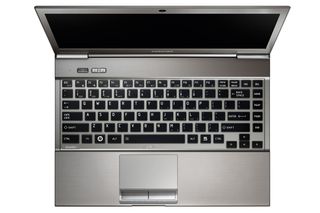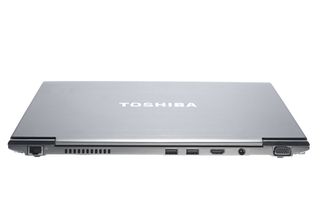
The shallow travel in each key made it difficult to tell if our presses had registered.
The touchpad directly below it is a good size and is made from a similar magnesium alloy to the main chassis. There's almost no friction, which makes navigating Windows quick and smooth, but we were less than impressed with the touchpad buttons underneath. Because the fingerprint reader has been placed directly between the two mouse buttons, they have had to shrink the size of the buttons as a result. This makes them harder for large fingers to press. There's a reasonable amount of travel in each button, but the slippery silver plastic finish detracts from what should be a premium laptop.

The Z830 has a useful selection of ports, including an Ethernet connector.
Beyond the fingerprint reader, business customers are sure to appreciate the full-size Ethernet port at the rear of the chassis. This will let you connect to a network without having to keep an adaptor close by as with some other ultra portable laptops. Joining it are two USB2 ports, a USB3 connector, a SDHC slot and a full-size HDMI port. There's also a VGA socket for connecting older displays and projectors. This may seem old-fashioned, but you're still likely to encounter displays and projectors with VGA connectors when out and about. Separate audio jacks for input and output means you won't need a specific headset for voice, although there is an integrated microphone for when you make video calls using the internal webcam.
